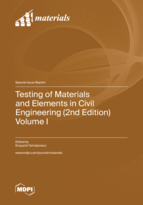Testing of Materials and Elements in Civil Engineering (2nd Edition)
A special issue of Materials (ISSN 1996-1944). This special issue belongs to the section "Construction and Building Materials".
Deadline for manuscript submissions: closed (10 November 2022) | Viewed by 125225
Special Issue Editor
Interests: nondestructive testing of building materials and elements; ultrasonic tomography in civil engineering; analysis of CT images obtained with ultrasound; computer knowledge representation of building materials and elements using nondestructive testing
Special Issues, Collections and Topics in MDPI journals
Special Issue Information
Last year, we ran a successful Special Issue on “Testing of Materials and Elements in Civil Engineering”, with over 50 papers published. The field of materials testing in civil engineering is very wide and interesting from an engineering and scientific point of view. Therefore, we have decided make a second edition dedicated to this topic.
This new Issue is proposed and organized as a means to present recent developments in the field of materials testing in civil engineering. The articles highlighted in this Issue should relate to different aspects of the testing of different materials in civil engineering, from building materials and elements to building structures. The current trend in the development of materials testing in civil engineering is mainly concerned with the detection of flaws and defects in elements and structures using destructive, semidestructive, and nondestructive testing.
It is my pleasure to invite you to submit a manuscript for this Special Issue mainly focused on novel different testing approaches, the development of single and hybrid measurement techniques, and advanced signal analysis.
The topics of interest include but are not limited to:
- Testing of materials and elements in civil engineering;
- Testing of structures made of novel materials;
- Condition assessment of civil materials and elements;
- Detecting defects that are invisible on the surface;
- Damage detection and damage imaging;
- Diagnostics of cultural heritage monuments;
- Structural health monitoring systems;
- Modeling and numerical analyses;
- Nondestructive testing methods;
- Advanced signal processing for nondestructive testing.
Prof. Dr. Krzysztof Schabowicz
Guest Editor
Manuscript Submission Information
Manuscripts should be submitted online at www.mdpi.com by registering and logging in to this website. Once you are registered, click here to go to the submission form. Manuscripts can be submitted until the deadline. All submissions that pass pre-check are peer-reviewed. Accepted papers will be published continuously in the journal (as soon as accepted) and will be listed together on the special issue website. Research articles, review articles as well as short communications are invited. For planned papers, a title and short abstract (about 100 words) can be sent to the Editorial Office for announcement on this website.
Submitted manuscripts should not have been published previously, nor be under consideration for publication elsewhere (except conference proceedings papers). All manuscripts are thoroughly refereed through a single-blind peer-review process. A guide for authors and other relevant information for submission of manuscripts is available on the Instructions for Authors page. Materials is an international peer-reviewed open access semimonthly journal published by MDPI.
Please visit the Instructions for Authors page before submitting a manuscript. The Article Processing Charge (APC) for publication in this open access journal is 2600 CHF (Swiss Francs). Submitted papers should be well formatted and use good English. Authors may use MDPI's English editing service prior to publication or during author revisions.
Keywords
- testing
- diagnostics
- building materials
- elements
- civil engineering
Related Special Issues
- Non-destructive Testing of Materials in Civil Engineering in Materials (26 articles)
- Non-Destructive Testing of Structures in Materials (24 articles)
- Testing of Materials and Elements in Civil Engineering in Materials (56 articles)
- Testing of Cement-Based Materials in Materials (20 articles)
- Structural Health Monitoring for Civil Engineering Materials in Materials (13 articles)
- Testing of Materials and Elements in Civil Engineering (4th Edition) in Materials (1 article)







